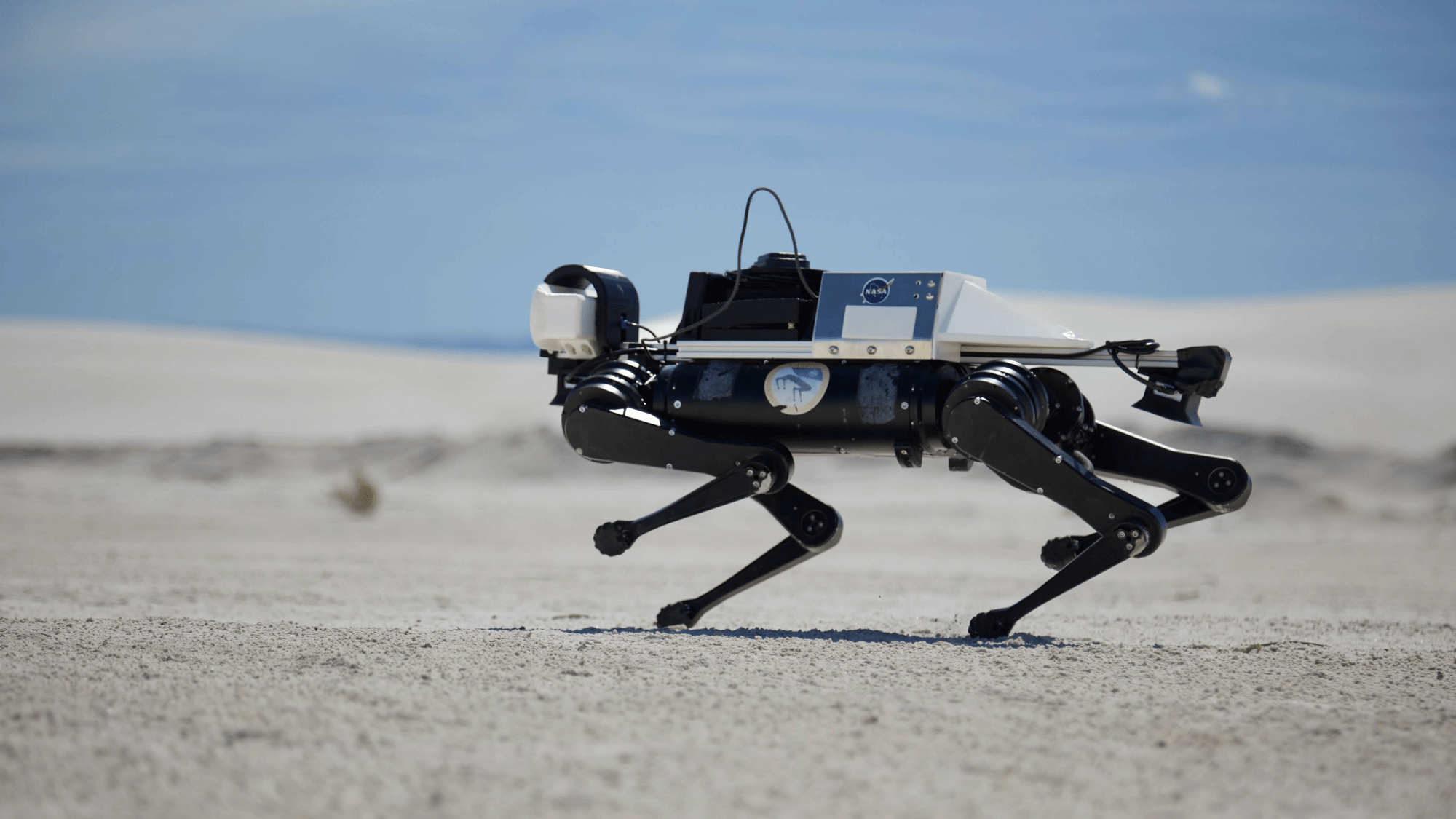Science
Robot Dog Set to Accompany Astronauts on Future Mars Missions

NASA may soon have a four-legged companion for astronauts venturing to Mars, but this companion will not be a traditional dog. Instead, researchers are developing a quadruped robot named Spirit, designed to assist astronauts by collecting samples and navigating challenging terrains on the Martian surface.
The robot’s autonomous capabilities allow it to operate independently, providing a unique advantage during exploration missions. A team from Oregon State University, University of Southern California, University of Pennsylvania, and Texas A&M University recently tested a prototype of this robot at White Sands National Park in New Mexico. Over five days, the robot traversed the park’s loose, unpredictable soil, simulating conditions similar to those expected on Mars.
These tests follow previous experiments on Mount Hood in Oregon, where the terrain mimicked lunar conditions. The insights gained from these two locations are expected to enhance the robot’s capabilities, preparing it for potential missions to both the Moon and Mars. The initiative is part of the LASSIE (Legged Autonomous Surface Science in Analog Environments) Project, aiming to develop independent robotic partners for astronauts.
A recent video showcased Spirit navigating the sandy landscape, featuring a series of cameras on its “head” to aid in visual processing. The robot’s movements produced a distinct sound, reminiscent of animated characters, as it interacted with the environment. During tests, Spirit worked alongside a larger, four-wheeled rover, demonstrating the potential for collaboration between different types of robotic systems.
Researchers emphasize the importance of adapting quadruped robots for extraterrestrial exploration. “Our group is very committed to putting quadrupeds on the Moon and on Mars,” stated Cristina Wilson, a robotics researcher at Oregon State University. She highlighted the unique advantages that legged robots offer in navigating challenging terrains.
The use of a robot dog is significant, as previous Martian missions have primarily relied on wheeled rovers. While NASA’s Sojourner rover landed on Mars in 1997, followed by Spirit and Opportunity in subsequent years, quadruped robots are designed to tackle terrains that may be inaccessible to their wheeled counterparts. With four adaptable legs, Spirit employs proprioceptive sensing, enabling it to detect variations in surface texture and maintain stability, much like a real dog.
The recent testing phase also focused on refining the algorithms that enable Spirit to operate autonomously. By employing computer vision and machine learning, the robot can theoretically identify optimal paths and conduct sample collection through a method called “adaptive sampling.” This capability could significantly enhance the efficiency of scientific investigation on future missions.
The testing location, White Sands National Park, was chosen for its resemblance to Martian environments, featuring active gypsum dune fields and varied sedimentary textures. Despite the challenges, including extreme heat during testing, the site provided valuable data to assess the robot’s performance.
While NASA does not plan to send actual dogs to Mars, the research team is incorporating lessons from canine behavior into the development of Spirit. For instance, Wilson’s German shepherd, Howard, demonstrated intuitive navigation skills that can inform improvements in the robot’s design.
The overarching goal of the LASSIE Project is to create a reliable robot dog that could accompany astronauts, potentially redefining how humans explore other planets. As research continues, the dream of having a robotic companion on Mars draws closer to reality.
-

 Technology5 months ago
Technology5 months agoDiscover the Top 10 Calorie Counting Apps of 2025
-

 Health3 months ago
Health3 months agoBella Hadid Shares Health Update After Treatment for Lyme Disease
-

 Health3 months ago
Health3 months agoErin Bates Shares Recovery Update Following Sepsis Complications
-

 Technology4 months ago
Technology4 months agoDiscover How to Reverse Image Search Using ChatGPT Effortlessly
-

 Technology1 month ago
Technology1 month agoDiscover 2025’s Top GPUs for Exceptional 4K Gaming Performance
-

 Technology3 months ago
Technology3 months agoElectric Moto Influencer Surronster Arrested in Tijuana
-

 Technology5 months ago
Technology5 months agoMeta Initiates $60B AI Data Center Expansion, Starting in Ohio
-

 Technology5 months ago
Technology5 months agoRecovering a Suspended TikTok Account: A Step-by-Step Guide
-

 Health4 months ago
Health4 months agoTested: Rab Firewall Mountain Jacket Survives Harsh Conditions
-

 Lifestyle5 months ago
Lifestyle5 months agoBelton Family Reunites After Daughter Survives Hill Country Floods
-

 Health3 months ago
Health3 months agoAnalysts Project Stronger Growth for Apple’s iPhone 17 Lineup
-

 Technology4 months ago
Technology4 months agoHarmonic Launches AI Chatbot App to Transform Mathematical Reasoning



















